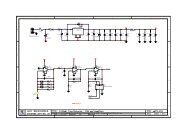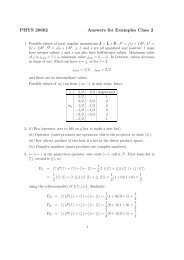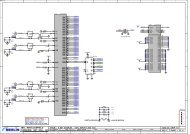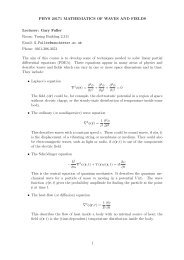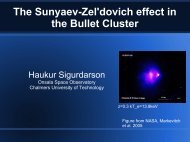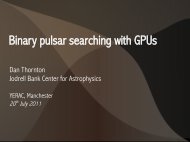l71 psr j1124j5916: discovery of a young energetic pulsar in the ...
l71 psr j1124j5916: discovery of a young energetic pulsar in the ...
l71 psr j1124j5916: discovery of a young energetic pulsar in the ...
Create successful ePaper yourself
Turn your PDF publications into a flip-book with our unique Google optimized e-Paper software.
The Astrophysical Journal, 567:L71–L75, 2002 March 1<br />
2002. The American Astronomical Society. All rights reserved. Pr<strong>in</strong>ted <strong>in</strong> U.S.A.<br />
PSR J11245916: DISCOVERY OF A YOUNG ENERGETIC PULSAR IN THE SUPERNOVA REMNANT G292.01.8<br />
F. Camilo, 1 R. N. Manchester, 2 B. M. Gaensler, 3 D. R. Lorimer, 4 and J. Sarkissian 5<br />
Received 2001 November 26; accepted 2002 January 22; published 2002 February 8<br />
ABSTRACT<br />
We report <strong>the</strong> <strong>discovery</strong> with <strong>the</strong> Parkes radio telescope <strong>of</strong> a <strong>pulsar</strong> associated with <strong>the</strong> ∼1700 yr old oxygenrich<br />
composite supernova remnant G292.01.8. The <strong>pulsar</strong> PSR J11245916 has a period <strong>of</strong> 135 ms and a<br />
13<br />
period derivative <strong>of</strong> 7.4 # 10 , imply<strong>in</strong>g a characteristic age <strong>of</strong> 2900 yr, a sp<strong>in</strong>-down lum<strong>in</strong>osity <strong>of</strong> 1.2 #<br />
37<br />
ergs s 1 13<br />
10 , and a surface magnetic field strength <strong>of</strong> 1.0 # 10 G. Association between <strong>the</strong> <strong>pulsar</strong> and <strong>the</strong><br />
synchrotron nebula previously identified with Chandra with<strong>in</strong> this supernova remnant is confirmed by <strong>the</strong> subsequent<br />
detection <strong>of</strong> X-ray pulsations by Hughes et al. The <strong>pulsar</strong>’s flux density at 1400 MHz is very small,<br />
2<br />
S ≈ 80 mJy, but <strong>the</strong> radio lum<strong>in</strong>osity <strong>of</strong> Sd ∼ 2 mJy kpc 2 is not especially small, although it is 1 order <strong>of</strong><br />
magnitude smaller than that <strong>of</strong> <strong>the</strong> least lum<strong>in</strong>ous <strong>young</strong> <strong>pulsar</strong> previously known. This <strong>discovery</strong> suggests that<br />
very deep radio searches should be done for pulsations from <strong>pulsar</strong> w<strong>in</strong>d nebulae <strong>in</strong> which <strong>the</strong> central pulsed<br />
source is yet to be detected and possibly from o<strong>the</strong>r more exotic neutron stars.<br />
Subject head<strong>in</strong>gs: ISM: <strong>in</strong>dividual (G292.01.8) — <strong>pulsar</strong>s: <strong>in</strong>dividual (PSR J11245916) —<br />
supernova remnants<br />
1. INTRODUCTION<br />
The supernova remnant (SNR) G292.01.8 is one <strong>of</strong> only<br />
three oxygen-rich SNRs known <strong>in</strong> <strong>the</strong> Galaxy. The o<strong>the</strong>r two<br />
(Puppis A and Cassiopeia A) have central compact objects, <strong>the</strong><br />
nature <strong>of</strong> which, however, rema<strong>in</strong>s mysterious (e.g., Gaensler,<br />
Bock, & Stappers 2000a; Pavlov et al. 2000). At radio wavelengths,<br />
G292.01.8 has <strong>the</strong> appearance <strong>of</strong> a composite SNR,<br />
with a central peak and a shell ∼10 <strong>in</strong> diameter (Braun et al.<br />
1986). ASCA X-ray observations (Torii, Tsunemi, & Slane<br />
1998) detected a non<strong>the</strong>rmal nebula co<strong>in</strong>cident with <strong>the</strong> central<br />
radio component. Recent Chandra ACIS-S observations have<br />
shown this nebula to be ∼2 <strong>in</strong> extent and to conta<strong>in</strong> a resolved<br />
compact source located near its peak. This <strong>discovery</strong>, toge<strong>the</strong>r<br />
with <strong>the</strong> <strong>energetic</strong>s <strong>of</strong> <strong>the</strong> nebula, provides nearly <strong>in</strong>controvertible<br />
evidence for <strong>the</strong> existence <strong>of</strong> a <strong>pulsar</strong> power<strong>in</strong>g <strong>the</strong><br />
nebula (Hughes et al. 2001).<br />
The Chandra observations <strong>of</strong> G292.01.8 are a beautiful<br />
example <strong>of</strong> <strong>the</strong> recent flood <strong>of</strong> X-ray data with high spatial,<br />
temporal, and spectral resolution that is advanc<strong>in</strong>g dramatically<br />
our understand<strong>in</strong>g <strong>of</strong> <strong>the</strong> varied outcomes <strong>of</strong> supernova explosions.<br />
In particular, X-rays provide an important complement<br />
to <strong>the</strong> radio band, <strong>the</strong> traditional hunt<strong>in</strong>g ground <strong>of</strong> <strong>pulsar</strong><br />
studies.<br />
In this Letter we report <strong>the</strong> <strong>discovery</strong> and <strong>the</strong> key parameters<br />
<strong>of</strong> <strong>the</strong> <strong>pulsar</strong> <strong>in</strong> G292.01.8 <strong>in</strong> a deep observation with <strong>the</strong><br />
Parkes radio telescope. The characterization <strong>of</strong> this <strong>young</strong> and<br />
<strong>energetic</strong> <strong>pulsar</strong> is important for <strong>the</strong> analysis <strong>of</strong> exist<strong>in</strong>g X-ray<br />
and radio data on G292.01.8. Moreover, this <strong>discovery</strong> has<br />
significant implications for <strong>the</strong> concept <strong>of</strong> “radio-quiet neutron<br />
stars.”<br />
1<br />
Columbia Astrophysics Laboratory, Columbia University, 550 West 120th<br />
Street, New York, NY 10027.<br />
2<br />
Australia Telescope National Facility, CSIRO, P.O. Box 76, Epp<strong>in</strong>g, NSW<br />
1710, Australia.<br />
3<br />
Harvard-Smithsonian Center for Astrophysics, 60 Garden Street, Cambridge,<br />
MA 02138.<br />
4<br />
University <strong>of</strong> Manchester, Jodrell Bank Observatory, Macclesfield, Cheshire,<br />
SK11 9DL, UK.<br />
5<br />
Australia Telescope National Facility, CSIRO, Parkes Observatory, P.O.<br />
Box 276, Parkes, NSW 2870, Australia.<br />
L71<br />
2. OBSERVATIONS<br />
The location <strong>of</strong> G292.01.8 was searched by <strong>the</strong> Parkes<br />
Multibeam Pulsar Survey <strong>of</strong> <strong>the</strong> <strong>in</strong>ner Galactic plane (260 !<br />
l ! 50; FbF ! 5), which has discovered more than 600 <strong>pulsar</strong>s<br />
(Manchester et al. 2001). The flux density limit at <strong>the</strong> location<br />
<strong>of</strong> <strong>the</strong> Chandra <strong>pulsar</strong> candidate was Sn<br />
≈ 0.3 mJy at a frequency<br />
<strong>of</strong> n p 1374 MHz. A similar limit was reached <strong>in</strong> a directed<br />
search <strong>of</strong> <strong>the</strong> SNR by Kaspi et al. (1996) at n p 1520 MHz. At<br />
a distance d ∼ 5 kpc (see below), <strong>the</strong> correspond<strong>in</strong>g lum<strong>in</strong>osity<br />
2<br />
limit is a not particularly constra<strong>in</strong><strong>in</strong>g L 1400 { S1400d ∼ 7 mJy<br />
kpc 2 : about 25% <strong>of</strong> known <strong>pulsar</strong>s have lum<strong>in</strong>osities below this<br />
value (see Fig. 1).<br />
On 2001 September 5 we searched <strong>the</strong> <strong>pulsar</strong> candidate position<br />
(see Table 1) at <strong>the</strong> Parkes telescope us<strong>in</strong>g <strong>the</strong> center beam<br />
<strong>of</strong> <strong>the</strong> multibeam receiver at a central frequency <strong>of</strong> 1374 MHz<br />
with a filter bank spectrometer hav<strong>in</strong>g 96 channels spann<strong>in</strong>g a<br />
total band <strong>of</strong> 288 MHz for each <strong>of</strong> two polarizations. Signals<br />
from each channel and polarization were square-law detected,<br />
high-pass filtered, and summed <strong>in</strong> polarization pairs. Each <strong>of</strong> <strong>the</strong><br />
96 channels was <strong>the</strong>n <strong>in</strong>tegrated and 1 bit digitized at 1 ms<br />
<strong>in</strong>tervals and recorded to magnetic tape for <strong>of</strong>f-l<strong>in</strong>e analysis. The<br />
total observation time was 10.2 hr.<br />
Standard search algorithms were used to reduce <strong>the</strong> data.<br />
First, strong narrowband radio <strong>in</strong>terference was identified and<br />
removed by mask<strong>in</strong>g five <strong>of</strong>fend<strong>in</strong>g frequency channels. Next,<br />
data from 2 25 time samples (9.3 hr) were dedispersed at 325<br />
3<br />
trial dispersion measures ( 0cm pc≤ DM ≤ 8800 cm 3 pc).<br />
Each <strong>of</strong> <strong>the</strong> 325 result<strong>in</strong>g time series was <strong>the</strong>n searched for<br />
periodic signals over a range <strong>of</strong> duty cycles with a fast Fourier<br />
transform–based code (described <strong>in</strong> detail by Lorimer et al. 2000)<br />
identify<strong>in</strong>g significant features <strong>in</strong> <strong>the</strong> fundamental amplitude<br />
spectrum as well as <strong>in</strong> spectra with two, four, eight, and 16<br />
harmonics folded <strong>in</strong>. F<strong>in</strong>ally, a limited but f<strong>in</strong>er search <strong>in</strong> period<br />
and DM was made <strong>of</strong> <strong>the</strong> entire data set for <strong>the</strong> best dispersed<br />
candidates from this stage. A good <strong>pulsar</strong> candidate was found<br />
with a signal-to-noise ratio <strong>of</strong> S/N p 12.4, a barycenter-corrected<br />
period <strong>of</strong> P p 135.3126 ms, and DM p 330 cm 3 pc.<br />
On 2001 October 3 we confirmed <strong>the</strong> <strong>pulsar</strong> with a detection<br />
<strong>of</strong> S/N p 8.8 <strong>in</strong> a 5 hr observation, with identical DM and<br />
P p 135.3144 ms, immediately imply<strong>in</strong>g a large period derivative<br />
<strong>of</strong> Ṗ p 7.4 # 10 13 . Follow<strong>in</strong>g <strong>the</strong> <strong>in</strong>itial radio detec-
L72 PSR J11245916 IN SNR G292.01.8 Vol. 567<br />
TABLE 1<br />
Parameters <strong>of</strong> PSR J11245916<br />
Parameter<br />
Value<br />
R.A. (J2000.0) a ............................... 11 24 39.1<br />
Decl. (J2000.0) a ............................... 59 16 20<br />
Period, P (s) .................................. 0.1353140749(2)<br />
13<br />
Period derivative, Ṗ .......................... 7.471(2) # 10<br />
Epoch (MJD) ................................. 52,180.0<br />
Dispersion measure, DM (cm 3 pc) ......... 330(2)<br />
Data span (MJD) ............................. 52,157–52,214<br />
Number <strong>of</strong> TOAs ............................. 10<br />
rms tim<strong>in</strong>g residual (ms) ..................... 5.8<br />
rms tim<strong>in</strong>g residual, “whitened” (ms) ....... 0.4<br />
Flux density at 1400 MHz, S 1400 (mJy) ...... 0.08(2)<br />
Derived parameters:<br />
Characteristic age, t c (yr) .................. 2900<br />
Sp<strong>in</strong>-down lum<strong>in</strong>osity, (ergs s 1 37<br />
Ė ) ....... 1.2 # 10<br />
Magnetic field strength, B (G) ............<br />
13<br />
1.0 # 10<br />
Distance, d (kpc) b .......................... ∼5<br />
Radio lum<strong>in</strong>osity, L (mJy kpc 2 1400 ) ........ ∼2<br />
Note.—Numbers <strong>in</strong> paren<strong>the</strong>ses represent 1 j uncerta<strong>in</strong>ties <strong>in</strong><br />
<strong>the</strong> least significant digits quoted.<br />
a<br />
Position known with ∼1 accuracy from Chandra data (Hughes<br />
et al. 2001). Units <strong>of</strong> right ascension are hours, m<strong>in</strong>utes, and seconds,<br />
and units <strong>of</strong> decl<strong>in</strong>ation are degrees, arcm<strong>in</strong>utes, and<br />
arcseconds.<br />
b<br />
Distance <strong>of</strong> SNR G292.01.8 (see text).<br />
Fig. 1.—Top: Radio lum<strong>in</strong>osities at 1400 MHz ( L 1400 ) for 828 <strong>pulsar</strong>s plotted<br />
vs. characteristic age tc. About 5% <strong>of</strong> known <strong>pulsar</strong>s have L1400<br />
below that <strong>of</strong><br />
PSR J11245916. Bottom: Data from top panel b<strong>in</strong>ned <strong>in</strong>to 12 groups <strong>of</strong> 69<br />
<strong>pulsar</strong>s each, with po<strong>in</strong>ts represent<strong>in</strong>g <strong>the</strong> mean <strong>of</strong> L1400 and tc<br />
<strong>in</strong> each b<strong>in</strong>,<br />
and a straight-l<strong>in</strong>e least-squares fit to <strong>the</strong> b<strong>in</strong>ned po<strong>in</strong>ts. The leftmost po<strong>in</strong>t<br />
( tc<br />
100 kyr) suggests that <strong>young</strong> <strong>pulsar</strong>s are not particularly lum<strong>in</strong>ous by<br />
comparison with middle-aged <strong>pulsar</strong>s ( 100 kyr tc<br />
5 Myr). Some lum<strong>in</strong>osity<br />
decay for larger ages is suggested by <strong>the</strong> straight-l<strong>in</strong>e fit.<br />
tion, new Chandra HRC data were searched for X-ray pulsations.<br />
As detailed by J. P. Hughes et al. (2002, <strong>in</strong> preparation)<br />
<strong>in</strong> a companion Letter, pulsations were found at a consistent<br />
period from <strong>the</strong> location <strong>of</strong> <strong>the</strong> previously identified <strong>pulsar</strong> w<strong>in</strong>d<br />
nebula (PWN), ensur<strong>in</strong>g beyond any doubt that we have discovered<br />
<strong>the</strong> <strong>pulsar</strong> near <strong>the</strong> center <strong>of</strong> SNR G292.01.8.<br />
The measured DM, toge<strong>the</strong>r with <strong>the</strong> Taylor & Cordes (1993)<br />
model for <strong>the</strong> Galactic distribution <strong>of</strong> free electrons, implies a<br />
<strong>pulsar</strong> distance <strong>of</strong> 11 kpc. However, <strong>the</strong> <strong>pulsar</strong> is located <strong>in</strong> <strong>the</strong><br />
direction <strong>of</strong> <strong>the</strong> Car<strong>in</strong>a spiral arm, where <strong>the</strong> model suffers from<br />
systematic errors. In fact, a new electron density/distance model<br />
(J. M. Cordes & T. J. Lazio 2002, <strong>in</strong> preparation) suggests a<br />
<strong>pulsar</strong> distance <strong>of</strong> 5.7 kpc (J. M. Cordes 2001, private communication).<br />
The SNR shows H i absorption to beyond <strong>the</strong> tangent<br />
po<strong>in</strong>t <strong>in</strong> this direction (Caswell et al. 1975), imply<strong>in</strong>g a<br />
lower limit on <strong>the</strong> distance <strong>of</strong> 3.2 kpc. S<strong>in</strong>ce <strong>the</strong> SNR shows<br />
absorption toward all more distant emission, no upper limit can<br />
be put on its distance from <strong>the</strong>se data. A distance estimate is<br />
also available from <strong>the</strong> observed value <strong>of</strong> redden<strong>in</strong>g, d ∼ 5.4 kpc<br />
(Goss et al. 1979). In light <strong>of</strong> <strong>the</strong>se various constra<strong>in</strong>ts on <strong>pulsar</strong>/<br />
SNR distance, we adopt hereafter <strong>the</strong> estimate d p 5 kpc.<br />
We have begun regular tim<strong>in</strong>g measurements <strong>of</strong> <strong>the</strong> new<br />
<strong>pulsar</strong> at <strong>the</strong> Parkes Observatory, with 3–5 hr typically needed<br />
to obta<strong>in</strong> a satisfactory pulse pr<strong>of</strong>ile and a correspond<strong>in</strong>g time<br />
<strong>of</strong> arrival (TOA). The average pulse pr<strong>of</strong>ile has a s<strong>in</strong>gle approximately<br />
symmetric component with FWHM ∼ 0.1P. Us<strong>in</strong>g<br />
<strong>the</strong> TOAs, <strong>the</strong> arcsecond-accuracy position measured with<br />
Chandra, and <strong>the</strong> TEMPO 6 tim<strong>in</strong>g s<strong>of</strong>tware, we have obta<strong>in</strong>ed<br />
a phase-connected solution, with <strong>the</strong> result<strong>in</strong>g sp<strong>in</strong> parameters<br />
6<br />
See http://<strong>pulsar</strong>.pr<strong>in</strong>ceton.edu/tempo.<br />
listed <strong>in</strong> Table 1. The <strong>pulsar</strong> appears to suffer a large amount<br />
<strong>of</strong> “tim<strong>in</strong>g noise,” with large and systematic residuals from <strong>the</strong><br />
second-order fit listed <strong>in</strong> Table 1. Fitt<strong>in</strong>g <strong>of</strong> four sp<strong>in</strong>-frequency<br />
derivatives removed <strong>the</strong> systematic component <strong>of</strong> this noise,<br />
leav<strong>in</strong>g a f<strong>in</strong>al rms tim<strong>in</strong>g residual <strong>of</strong> 0.4 ms. The signal-tonoise<br />
ratios have rema<strong>in</strong>ed constant when scaled by <strong>in</strong>tegration<br />
time, suggest<strong>in</strong>g that <strong>the</strong> <strong>pulsar</strong>’s flux is not greatly modulated<br />
by <strong>in</strong>terstellar sc<strong>in</strong>tillation. We use this and <strong>the</strong> known observ<strong>in</strong>g<br />
parameters, telescope ga<strong>in</strong>, and system temperature,<br />
<strong>in</strong>clud<strong>in</strong>g <strong>the</strong> contribution to <strong>the</strong> latter from <strong>the</strong> SNR (Lockhart<br />
et al. 1977), to estimate a flux density <strong>of</strong> 80 20 mJy.<br />
3. DISCUSSION<br />
The measured P and Ṗ <strong>of</strong> PSR J11245916 imply that it<br />
is a very <strong>young</strong> and <strong>energetic</strong> <strong>pulsar</strong>. The implied characteristic<br />
age and surface magnetic dipole field strength are<br />
19 1/2<br />
t p P/2P˙<br />
p 2900 yr and B p 3.2 # 10 (PP) ˙<br />
c<br />
p 1.0 #<br />
10 13 G, respectively. The sp<strong>in</strong>-down energy loss rate is Ė p<br />
2 3 37<br />
4p IP/P ˙ p 1.2 # 10 ergs s 1 (where a neutron star moment<br />
45<br />
<strong>of</strong> <strong>in</strong>ertia I p 10 g cm 2 has been used), <strong>in</strong> excellent agreement<br />
with <strong>the</strong> value predicted by Hughes et al. (2001) from <strong>the</strong> <strong>energetic</strong>s<br />
<strong>of</strong> <strong>the</strong> PWN, if d ∼ 5 kpc. In comparison with <strong>the</strong> sample<br />
<strong>of</strong> ∼1500 rotation-powered <strong>pulsar</strong>s known, J11245916 ranks<br />
as <strong>the</strong> sixth <strong>young</strong>est <strong>in</strong> terms <strong>of</strong> t c and <strong>the</strong> eighth most <strong>energetic</strong><br />
<strong>in</strong> terms <strong>of</strong> Ė.<br />
The age <strong>of</strong> G292.01.8 is derived to be 1700(d/5<br />
kpc) yr<br />
from a measurement <strong>of</strong> <strong>the</strong> high radial velocity, oxygen-rich<br />
material positionally co<strong>in</strong>cident with <strong>the</strong> central synchrotron<br />
nebula (Murd<strong>in</strong> & Clark 1979; Braun et al. 1983), while <strong>the</strong><br />
<strong>pulsar</strong> characteristic age is a factor <strong>of</strong> nearly 2 larger than this.<br />
Assum<strong>in</strong>g that <strong>the</strong> age estimate for <strong>the</strong> SNR represents <strong>the</strong> true<br />
age <strong>of</strong> <strong>the</strong> system, this discrepancy can be simply expla<strong>in</strong>ed if<br />
<strong>the</strong> <strong>in</strong>itial sp<strong>in</strong> period <strong>of</strong> PSR J11245916 was P0<br />
90 ms<br />
(e.g., Kaspi et al. 2001b; Murray et al. 2002). This is slower<br />
than for <strong>the</strong> six o<strong>the</strong>r <strong>young</strong> <strong>pulsar</strong>s whose <strong>in</strong>itial periods have<br />
been estimated, all <strong>of</strong> which have P 0 ! 60 ms. Alternatively,<br />
<strong>the</strong> <strong>pulsar</strong> may sp<strong>in</strong> down with a brak<strong>in</strong>g torque that is different<br />
from <strong>the</strong> usually assumed constant magnetic dipole. In a study
No. 1, 2002 CAMILO ET AL. L73<br />
PSR<br />
t c<br />
(kyr)<br />
TABLE 2<br />
Pulsars with Apparent Age <strong>of</strong> Less than 5 kyr<br />
P<br />
(ms)<br />
B<br />
(#10 12 G)<br />
Ė<br />
(#10 36 ergs s 1 ) SNR<br />
d<br />
(kpc)<br />
L 1400<br />
(mJy kpc 2 )<br />
J05376910 ...... 5.0 16 1 480 N157B 50 (LMC) !150<br />
B053121 ........ 1.3 33 4 440 Crab 2.0 40<br />
B054069 ........ 1.7 50 5 150 0540693 50 (LMC) 200<br />
J02056449 ...... 5.4 65 4 27 3C 58 2.6 2<br />
B150958 ........ 1.6 150 15 18 G320.41.2 5.2 35<br />
J11245916 ...... 2.9 135 10 12 G292.01.8 ∼5 ∼2<br />
J18460258 ...... 0.7 323 48 8 Kes 75 ∼19 50<br />
J18111926 ...... 24 65 2 6 G11.20.3 5 ! 2<br />
J11196127 ...... 1.6 407 41 2 G292.20.5 ∼6 ∼30<br />
Note.—We list <strong>in</strong> order <strong>of</strong> decreas<strong>in</strong>g sp<strong>in</strong>-down lum<strong>in</strong>osity Ė all known <strong>pulsar</strong>s for which <strong>the</strong> characteristic<br />
age t c ! 5 kyr or for which <strong>the</strong> <strong>pulsar</strong> is possibly associated with a historical supernova (J02056449: SN 1181;<br />
J18111926: SN 386).<br />
<strong>of</strong> <strong>pulsar</strong> population dynamics, Cordes & Chern<strong>of</strong>f (1998) suggest<br />
alternative forms <strong>of</strong> brak<strong>in</strong>g torque (e.g., a brak<strong>in</strong>g <strong>in</strong>dex<br />
<strong>of</strong> 2.5 with a magnetic field decay time <strong>of</strong> ∼6 Myr) that result<br />
<strong>in</strong> actual <strong>pulsar</strong> ages smaller than t c by a factor <strong>of</strong> 2. In <strong>the</strong><br />
absence <strong>of</strong> a measured brak<strong>in</strong>g <strong>in</strong>dex for PSR J11245916,<br />
we tentatively regard a relatively large P 0 as a preferred explanation.<br />
In Table 2 we summarize key parameters for <strong>the</strong> <strong>young</strong>est<br />
rotation-powered <strong>pulsar</strong>s known, ordered by decreas<strong>in</strong>g Ė.<br />
Head<strong>in</strong>g <strong>the</strong> list are <strong>the</strong> three “Crab-like” <strong>pulsar</strong>s, with extremely<br />
large Ė. The rema<strong>in</strong><strong>in</strong>g six <strong>young</strong> <strong>pulsar</strong>s are varied<br />
<strong>in</strong> <strong>the</strong>ir properties and generally follow <strong>the</strong> trend <strong>of</strong> <strong>in</strong>creas<strong>in</strong>g<br />
P and B with decreas<strong>in</strong>g Ė (with <strong>the</strong> <strong>pulsar</strong> <strong>in</strong> G11.20.3 a<br />
notable exception). Their sp<strong>in</strong>-down lum<strong>in</strong>osities are 20–200<br />
times lower than that <strong>of</strong> <strong>the</strong> Crab <strong>pulsar</strong>’s, and many are <strong>the</strong>refore<br />
difficult to detect: four were discovered just <strong>in</strong> <strong>the</strong> past<br />
2 years (two each <strong>in</strong> radio and X-rays).<br />
In its sp<strong>in</strong> parameters, PSR J11245916 is most similar to<br />
PSR B150958 (see Table 2). It is <strong>in</strong>terest<strong>in</strong>g to note that <strong>the</strong>ir<br />
respective PWNe also have comparable lum<strong>in</strong>osities. In <strong>the</strong><br />
0.2–4 keV X-ray band, we f<strong>in</strong>d for <strong>the</strong> PWN powered by<br />
J11245916 7 34 1<br />
that L ergs s ˙<br />
X p 6 # 10 p 0.005E for a distance<br />
<strong>of</strong> 5 kpc (Hughes et al. 2001), while for B150958 we<br />
35 1<br />
f<strong>in</strong>d L ergs s ˙<br />
X p 2 # 10 p 0.01E <strong>in</strong> <strong>the</strong> same energy range<br />
(Gaensler et al. 2002). For <strong>the</strong>ir respective radio PWNe, we f<strong>in</strong>d<br />
33 1<br />
L ergs s ˙<br />
R p 4 # 10 p 0.0003E for J11245916 (Hughes<br />
33 1<br />
et al. 2001), while L ergs s ˙<br />
R ∼ 5 # 10 p 0.0003E for<br />
B150958 (Gaensler et al. 2002).<br />
Thus, <strong>the</strong> efficiencies with which <strong>the</strong>se <strong>pulsar</strong>s power <strong>the</strong>ir<br />
X-ray nebulae differ by a factor <strong>of</strong> only ∼2, while those for<br />
<strong>the</strong>ir radio nebulae are approximately equal. Although <strong>the</strong>se<br />
<strong>pulsar</strong>s have comparable sp<strong>in</strong> parameters, we expla<strong>in</strong> below<br />
that <strong>the</strong>ir PWNe have quite different environments and likely<br />
evolutionary histories. It is <strong>the</strong>refore surpris<strong>in</strong>g that <strong>the</strong> efficiencies<br />
with which <strong>the</strong>y convert <strong>the</strong>ir sp<strong>in</strong>-down <strong>in</strong>to nebular<br />
flux are so similar.<br />
In <strong>the</strong> radio band, it has been argued that a <strong>pulsar</strong>’s <strong>in</strong>itial<br />
parameters can make a crucial difference to <strong>the</strong> resultant lum<strong>in</strong>osity<br />
<strong>of</strong> its PWN at later times (e.g., Bhattacharya 1990).<br />
If a <strong>pulsar</strong> is born sp<strong>in</strong>n<strong>in</strong>g rapidly and has a high magnetic<br />
field, it will dump most <strong>of</strong> its sp<strong>in</strong>-down energy <strong>in</strong>to its surround<strong>in</strong>g<br />
nebula at <strong>the</strong> earliest stages, when adiabatic losses<br />
are most severe; this will result <strong>in</strong> a comparatively under-<br />
7<br />
The photon <strong>in</strong>dex <strong>of</strong> this source could not be measured from <strong>the</strong> Chandra<br />
observations <strong>of</strong> Hughes et al. (2001) because <strong>of</strong> contam<strong>in</strong>ation by <strong>the</strong>rmal<br />
emission from <strong>the</strong> SNR. We assume a photon <strong>in</strong>dex <strong>of</strong> G p 2, as is typical<br />
for such sources.<br />
lum<strong>in</strong>ous radio PWN (Bhattacharya 1990; Crawford et al.<br />
2001). However, a <strong>pulsar</strong> that is o<strong>the</strong>rwise similar but born<br />
sp<strong>in</strong>n<strong>in</strong>g more slowly will not release its energy so quickly, so<br />
that its nebula will suffer less from expansion losses and will<br />
be correspond<strong>in</strong>gly brighter at radio wavelengths. We have<br />
argued above that PSR J11245916 was possibly born with<br />
a comparatively long sp<strong>in</strong> period, P0<br />
90 ms, while PSR<br />
B150958 is generally assumed to have been born with a Crablike<br />
sp<strong>in</strong> period <strong>of</strong> P0<br />
≈ 20 ms (Bhattacharya 1990). The comparable<br />
values <strong>of</strong> L R for <strong>the</strong>ir PWNe are <strong>the</strong>refore not easily<br />
expla<strong>in</strong>ed.<br />
Fur<strong>the</strong>rmore, that <strong>the</strong> radio and X-ray extents <strong>of</strong> <strong>the</strong> PWN<br />
powered by PSR B150958 are approximately equal <strong>in</strong>dicates<br />
that synchrotron cool<strong>in</strong>g does not yet dom<strong>in</strong>ate <strong>the</strong> nebula at<br />
high energies (Gaensler et al. 2002) and can account for this<br />
nebula’s comparatively low X-ray efficiency (Chevalier et al.<br />
2000). However, for PSR J11245916 <strong>the</strong> X-ray nebula is<br />
noticeably smaller than its radio counterpart (Hughes et al.<br />
2001; B. M. Gaensler & B. J. Wallace 2002, <strong>in</strong> preparation),<br />
<strong>in</strong>dicat<strong>in</strong>g that <strong>the</strong> X-ray–emitt<strong>in</strong>g electrons are <strong>in</strong> this case<br />
efficient radiators. Thus, we expect <strong>the</strong> X-ray lum<strong>in</strong>osity <strong>of</strong> <strong>the</strong><br />
PWN around J11245916 to be much larger than observed,<br />
closer to <strong>the</strong> factor L ˙<br />
X ≈ 0.05E seen for <strong>the</strong> Crab Nebula and<br />
o<strong>the</strong>r X-ray PWNe dom<strong>in</strong>ated by radiative losses (Chevalier<br />
2000).<br />
Thus, both LR<br />
and LX<br />
for <strong>the</strong> PWN powered by PSR<br />
J11245916 are much lower than expected through simple<br />
physical arguments. There are a variety <strong>of</strong> o<strong>the</strong>r factors that<br />
can affect <strong>the</strong> lum<strong>in</strong>osity <strong>of</strong> a PWN: <strong>the</strong> <strong>pulsar</strong> brak<strong>in</strong>g <strong>in</strong>dex,<br />
PWN magnetic field, and nebular expansion velocity are all<br />
important parameters at radio wavelengths (Reynolds & Chevalier<br />
1984; Crawford et al. 2001), while <strong>the</strong> Lorentz factor <strong>of</strong><br />
<strong>the</strong> w<strong>in</strong>d, <strong>the</strong> radius <strong>of</strong> <strong>the</strong> term<strong>in</strong>ation shock, and <strong>the</strong> magnetization<br />
parameter j all have a strong bear<strong>in</strong>g on <strong>the</strong> nebula’s<br />
X-ray lum<strong>in</strong>osity (Chevalier 2000). The unexpectedly similar<br />
nebular efficiencies for PSRs J11245916 and B150958,<br />
along with <strong>the</strong> large range <strong>of</strong> efficiencies among <strong>the</strong> o<strong>the</strong>r<br />
<strong>young</strong> <strong>pulsar</strong>s <strong>in</strong> Table 2, emphasize that we still lack a detailed<br />
understand<strong>in</strong>g <strong>of</strong> how a <strong>pulsar</strong> ultimately deposits its energy.<br />
One particularly <strong>in</strong>terest<strong>in</strong>g <strong>young</strong> <strong>pulsar</strong> <strong>in</strong> this regard is<br />
PSR J11196127 (Camilo et al. 2000; Table 2), which has no<br />
known radio-bright PWN down to extremely constra<strong>in</strong><strong>in</strong>g surface<br />
brightness limits (Crawford et al. 2001). It also has no<br />
confirmed X-ray–bright PWN (although a possible candidate<br />
was detected by Pivovar<strong>of</strong>f et al. 2001). This example, toge<strong>the</strong>r<br />
with several relatively <strong>young</strong> and <strong>energetic</strong> <strong>pulsar</strong>s that do not<br />
power detectable PWNe (Gaensler et al. 2000b), suggests that
L74 PSR J11245916 IN SNR G292.01.8 Vol. 567<br />
<strong>pulsar</strong> environments need not be good “calorimeters.” Thus,<br />
some <strong>young</strong> <strong>pulsar</strong>s may pass unnoticed unless <strong>the</strong>ir beamed<br />
radiation is favorably oriented so that pulsations may be<br />
detected.<br />
The fact that radio <strong>pulsar</strong> beams do not <strong>in</strong> general sweep<br />
4p sr is a fact <strong>of</strong> life. Although it is generally accepted that<br />
<strong>the</strong> beam<strong>in</strong>g fraction f is period dependent, with short-period<br />
<strong>pulsar</strong>s beam<strong>in</strong>g to a larger fraction <strong>of</strong> <strong>the</strong> sky than <strong>the</strong>ir longperiod<br />
counterparts, a consensus has yet to emerge on <strong>the</strong> form<br />
<strong>of</strong> f(P) . Pulse width analyses suggest that f ≈ 0.3 for a <strong>pulsar</strong><br />
with P ∼ 0.1 s (Tauris & Manchester 1998), while from an<br />
analysis <strong>of</strong> <strong>pulsar</strong>-PWN associations, Frail & M<strong>of</strong>fett (1993)<br />
f<strong>in</strong>d f ≈ 0.6. S<strong>in</strong>ce PWNe are regarded as unambiguous <strong>in</strong>di-<br />
cators that a <strong>young</strong> <strong>pulsar</strong> is present, <strong>the</strong> failure to detect pulsations<br />
toward such sources is usually ascribed solely to a<br />
misoriented <strong>pulsar</strong> beam. However, <strong>the</strong> case <strong>of</strong> G292.01.8 and<br />
its fa<strong>in</strong>t radio <strong>pulsar</strong> highlights an important caveat: <strong>the</strong> radio<br />
lum<strong>in</strong>osity 8 limit implied by a nondetection should now be below<br />
at least L mJy kpc 2 1400 ∼ 1 , approximately <strong>the</strong> lum<strong>in</strong>osity <strong>of</strong><br />
PSR J11245916, and possibly as low as 0.1 mJy kpc 2 (see<br />
Fig. 1), before one can <strong>in</strong>voke unfavorable beam<strong>in</strong>g as an<br />
explanation.<br />
Various analyses (e.g., Emmer<strong>in</strong>g & Chevalier 1989) have<br />
suggested that <strong>young</strong> <strong>pulsar</strong>s have higher radio lum<strong>in</strong>osities than<br />
older ones. Figure 1 shows that <strong>the</strong> basis for such arguments is<br />
weak <strong>in</strong> <strong>the</strong> case <strong>of</strong> very <strong>young</strong> <strong>pulsar</strong>s. The least lum<strong>in</strong>ous radio<br />
<strong>pulsar</strong> previously detected for which t c ! 10 kyr had L1400<br />
∼<br />
30 mJy kpc 2 . The fact that some X-ray–detected <strong>pulsar</strong>s have<br />
had much more constra<strong>in</strong><strong>in</strong>g lum<strong>in</strong>osity limits put on <strong>the</strong>ir radio<br />
emission (e.g., Crawford et al. 1998; Table 2) has usually been<br />
taken to imply that <strong>the</strong>se <strong>pulsar</strong>s have radio beams that are not<br />
directed toward us. However, <strong>the</strong> <strong>discovery</strong> <strong>of</strong> PSR J11245916<br />
shows that very <strong>young</strong> <strong>pulsar</strong>s can certa<strong>in</strong>ly have much lower<br />
8<br />
The radio lum<strong>in</strong>osities we discuss here are really “pseudolum<strong>in</strong>osities”:<br />
<strong>the</strong>y assume that <strong>the</strong> total lum<strong>in</strong>osity is proportional to <strong>the</strong> <strong>in</strong>tegrated flux<br />
density <strong>of</strong> <strong>the</strong> observed cut across <strong>the</strong> radio beam. A realistic discussion <strong>of</strong><br />
actual lum<strong>in</strong>osities depends crucially on <strong>the</strong> generally unknown <strong>pulsar</strong> beam<br />
shape: e.g., for a beam with exponential roll <strong>of</strong>f, <strong>the</strong> measured flux density—and<br />
<strong>the</strong>refore pseudolum<strong>in</strong>osity—can be arbitrarily low depend<strong>in</strong>g on<br />
<strong>the</strong> view<strong>in</strong>g impact angle, even for a large beam-averaged lum<strong>in</strong>osity. Here<br />
primarily we are concerned with empirically determ<strong>in</strong>ed “lum<strong>in</strong>osities,” i.e.,<br />
with pseudolum<strong>in</strong>osities.<br />
radio lum<strong>in</strong>osities than previously thought, due ei<strong>the</strong>r to <strong>in</strong>tr<strong>in</strong>sically<br />
low lum<strong>in</strong>osity or to our l<strong>in</strong>e <strong>of</strong> sight cutt<strong>in</strong>g only lowlevel<br />
w<strong>in</strong>gs on <strong>the</strong> emitted beam.<br />
The above discussion serves as a cautionary tale <strong>in</strong> <strong>the</strong> context<br />
<strong>of</strong> discussions <strong>of</strong> exotic sources, such as <strong>the</strong> “radio-quiet<br />
neutron stars” (RQNSs), “anomalous X-ray <strong>pulsar</strong>s” (AXPs)<br />
and “s<strong>of</strong>t g-ray repeaters” (SGRs). While <strong>the</strong>re is no question<br />
that <strong>the</strong>se sources have properties that make <strong>the</strong>m dist<strong>in</strong>ct from<br />
“normal” radio <strong>pulsar</strong>s (e.g., Got<strong>the</strong>lf, Petre, & Vasisht 1999;<br />
Pivovar<strong>of</strong>f, Kaspi, & Camilo 2000; Gaensler et al. 2000a; Kaspi<br />
et al. 2001a; Chakrabarty et al. 2001), <strong>the</strong> fact that none <strong>of</strong><br />
<strong>the</strong>se sources has been detected at radio wavelengths has been<br />
taken to imply that <strong>the</strong>ir radio pulse mechanism must be <strong>in</strong>active<br />
(Bar<strong>in</strong>g & Hard<strong>in</strong>g 1998; Zhang & Hard<strong>in</strong>g 2000; Zhang<br />
2001). However, <strong>the</strong> radio lum<strong>in</strong>osity limits for many <strong>of</strong> <strong>the</strong>se<br />
sources are not particularly str<strong>in</strong>gent by <strong>the</strong> standard <strong>of</strong> radio<br />
<strong>pulsar</strong>s, and <strong>the</strong>re are so few <strong>of</strong> <strong>the</strong>se objects known that <strong>the</strong>y<br />
all could be radio lum<strong>in</strong>ous and yet all could still be beam<strong>in</strong>g<br />
away from us (Gaensler et al. 2001). It may well be that <strong>the</strong><br />
RQNSs, AXPs, and SGRs are all truly radio-silent, but this<br />
conclusion is difficult to justify until <strong>the</strong> lum<strong>in</strong>osity limits<br />
available for such objects reach a level equivalent to at least<br />
<strong>the</strong> smallest radio lum<strong>in</strong>osities observed for radio <strong>pulsar</strong>s,<br />
L ∼ 0.1<br />
1400<br />
values.<br />
mJy kpc 2 (Fig. 1), and <strong>in</strong> pr<strong>in</strong>ciple even smaller<br />
With <strong>the</strong> <strong>discovery</strong> <strong>of</strong> PSR J11245916, G292.01.8 becomes<br />
<strong>the</strong> second example <strong>of</strong> an oxygen-rich SNR with a confirmed<br />
rapidly sp<strong>in</strong>n<strong>in</strong>g <strong>pulsar</strong> (after 0540693 <strong>in</strong> <strong>the</strong> Large<br />
Magellanic Cloud). The true nature <strong>of</strong> <strong>the</strong> compact sources <strong>in</strong><br />
<strong>the</strong> o<strong>the</strong>r two Galactic oxygen-rich SNRs rema<strong>in</strong>s to be seen.<br />
This <strong>discovery</strong> also suggests that very deep searches for radio<br />
pulsations from known PWNe and possibly o<strong>the</strong>r more exotic<br />
neutron stars may be well worthwhile.<br />
We are deeply grateful to John Reynolds for his support <strong>of</strong><br />
this project. The Parkes radio telescope is part <strong>of</strong> <strong>the</strong> Australia<br />
Telescope, which is funded by <strong>the</strong> Commonwealth <strong>of</strong> Australia<br />
for operation as a National Facility managed by <strong>the</strong> CSIRO.<br />
F. C. acknowledges support from NASA grant NAG 5-9095.<br />
B. M. G. is supported by a Clay Fellowship awarded by <strong>the</strong><br />
Harvard-Smithsonian Center for Astrophysics. D. R. L. is a<br />
University Research Fellow funded by <strong>the</strong> Royal Society.<br />
REFERENCES<br />
Bar<strong>in</strong>g, M. G., & Hard<strong>in</strong>g, A. K. 1998, ApJ, 507, L55<br />
Bhattacharya, D. 1990, J. Astrophys. Astron., 11, 125<br />
Braun, R., Goss, W. M., Caswell, J. L., & Roger, R. S. 1986, A&A, 162, 259<br />
Braun, R., Goss, W. M., Danziger, I. J., & Boksenberg, A. 1983, <strong>in</strong> IAU Symp.<br />
101, Supernova Remnants and Their X-Ray Emission, ed. P. Gorenste<strong>in</strong> &<br />
J. Danziger (Dordrecht: Reidel), 159<br />
Camilo, F., Kaspi, V. M., Lyne, A. G., Manchester, R. N., Bell, J. F., D’Amico,<br />
N., McKay, N. P. F., & Crawford, F. 2000, ApJ, 541, 367<br />
Caswell, J. L., Murray, J. D., Roger, R. S., Cole, D. J., & Cooke, D. J. 1975,<br />
A&A, 45, 239<br />
Chakrabarty, D., Pivovar<strong>of</strong>f, M. J., Hernquist, L. E., Heyl, J. S., & Narayan,<br />
R. 2001, ApJ, 548, 800<br />
Chevalier, R. A. 2000, ApJ, 539, L45<br />
Cordes, J. M., & Chern<strong>of</strong>f, D. F. 1998, ApJ, 505, 315<br />
Crawford, F., Gaensler, B. M., Kaspi, V. M., Manchester, R. N., Camilo, F.,<br />
Lyne, A. G., & Pivovar<strong>of</strong>f, M. J. 2001, ApJ, 554, 152<br />
Crawford, F., Kaspi, V. M., Manchester, R. N., Camilo, F., Lyne, A. G., &<br />
D’Amico, N. 1998, Mem. Soc. Astron. Italiana, 69, 951<br />
Emmer<strong>in</strong>g, R. T., & Chevalier, R. A. 1989, ApJ, 345, 931<br />
Frail, D. A., & M<strong>of</strong>fett, D. A. 1993, ApJ, 408, 637<br />
Gaensler, B. M., Arons, J., Kaspi, V. M., Pivovar<strong>of</strong>f, M. J., Kawai, N., &<br />
Tamura, K. 2002, ApJ, <strong>in</strong> press (astro-ph/0110454)<br />
Gaensler, B. M., Bock, D. C.-J., & Stappers, B. W. 2000a, ApJ, 537, L35<br />
Gaensler, B. M., Slane, P. O., Got<strong>the</strong>lf, E. V., & Vasisht, G. 2001, ApJ, 559,<br />
963<br />
Gaensler, B. M., Stappers, B. W., Frail, D. A., M<strong>of</strong>fett, D. A., Johnston, S.,<br />
& Chatterjee, S. 2000b, MNRAS, 318, 58<br />
Goss, W. M., Shaver, P. A., Zealey, W. J., Murd<strong>in</strong>, P., & Clark, D. H. 1979,<br />
MNRAS, 188, 357<br />
Got<strong>the</strong>lf, E. V., Petre, R., & Vasisht, G. 1999, ApJ, 514, L107<br />
Hughes, J. P., Slane, P. O., Burrows, D. N., Garmire, G., Nousek, J. A., Olbert,<br />
C. M., & Keohane, J. W. 2001, ApJ, 559, L153<br />
Kaspi, V. M., Gavriil, F. P., Chakrabarty, D., Lackey, J. R., & Muno, M. P.<br />
2001a, ApJ, 558, 253<br />
Kaspi, V. M., Manchester, R. N., Johnston, S., Lyne, A. G., & D’Amico, N.<br />
1996, AJ, 111, 2028<br />
Kaspi, V. M., Roberts, M. E., Vasisht, G., Got<strong>the</strong>lf, E. V., Pivovar<strong>of</strong>f, M., &<br />
Kawai, N. 2001b, ApJ, 560, 371<br />
Lockhart, I. A., Goss, W. M., Caswell, J. L., & McAdam, W. B. 1977, MNRAS,<br />
179, 147<br />
Lorimer, D. R., Kramer, M., Müller, P., Wex, N., Jessner, A., Lange, C., &<br />
Wieleb<strong>in</strong>ski, R. 2000, A&A, 358, 169<br />
Manchester, R. N., et al. 2001, MNRAS, 328, 17<br />
Murd<strong>in</strong>, P., & Clark, D. H. 1979, MNRAS, 189, 501<br />
Murray, S. S., Slane, P. O., Seward, F. D., Ransom, S. M., & Gaensler,<br />
B. M. 2002, ApJ, <strong>in</strong> press (astro-ph/0108489)
No. 1, 2002 CAMILO ET AL. L75<br />
Pavlov, G. G., Zavl<strong>in</strong>, V. E., Aschenbach, B., Trümper, J., & Sanwal, D. 2000,<br />
ApJ, 531, L53<br />
Pivovar<strong>of</strong>f, M., Kaspi, V. M., & Camilo, F. 2000, ApJ, 535, 379<br />
Pivovar<strong>of</strong>f, M., Kaspi, V. M., Camilo, F., Gaensler, B. M., & Crawford, F.<br />
2001, ApJ, 554, 161<br />
Reynolds, S. P., & Chevalier, R. A. 1984, ApJ, 278, 630<br />
Tauris, T. M., & Manchester, R. N. 1998, MNRAS, 298, 625<br />
Taylor, J. H., & Cordes, J. M. 1993, ApJ, 411, 674<br />
Torii, K., Tsunemi, H., & Slane, P. 1998, <strong>in</strong> IAU Symp. 188, The Hot Universe,<br />
ed. K. Koyama, S. Kitamoto, & M. Itoh (Dordrecht: Kluwer), 258<br />
Zhang, B. 2001, ApJ, 562, L59<br />
Zhang, B., & Hard<strong>in</strong>g, A. K. 2000, ApJ, 535, L51



